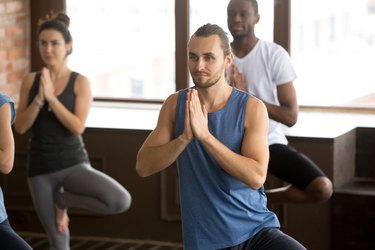
The work you do in the gym or on the yoga mat prepares you for the remaining 23 hours of your day. Yoga, in particular, promotes physical balance and a balanced lifestyle beyond the mat.
So while consistent yoga practice can help you feel more centered and aligned as you float from pose to pose, the benefits of standing yoga poses will follow you for the rest of your day.
Video of the Day
Video of the Day
Benefits of Standing Yoga Poses
Standing yoga poses can help you develop your body's balance, muscle engagement and alignment, says certified yoga instructor Remy Park. While many standing poses may seem simple at first glance, they become more challenging and beneficial as you recruit different muscles across your body.
"You can really put as much or as little effort into each standing posture as you'd like," she says. "But what I love about yoga is there is always room for improvement no matter what your practice looks like."
And with regular practice, you can develop a heightened bodily awareness, too, Park says. This mindfulness can help improve your posture at your office desk or your gait as you walk down the street.
1. Mountain Pose (Tadasana)

The basics of mountain pose are simple enough — it boils down to standing. But standing with proper form takes time and patience to retrain your body to immediately find correct alignment.
- Stand up straight with your spine in a neutral position.
- Roll your shoulders back and down with arms at your sides, palms facing out (or in prayer at the center of your chest).
- Hold for at least 5 breaths (or as long as you'd like).
Muscles used: abdominal muscles, back muscles, leg muscles
Tip
For an even greater challenge, close your eyes during this exercise.
2. Tree Pose (Vrksasana)

By practicing this pose frequently, you'll improve your single-leg strength and build hip and oblique strength, which is important in maintaining your balance. When you feel stable enough in this pose, try closing your eyes.
- Begin in mountain pose (see above).
- Reach down with your right hand and place your right foot on your ankle, shin or inner thigh (not on your knee).
- Square your hips forward and place your hands at heart center or above your head.
- Hold for 5 to 10 breaths.
Muscles used: glute muscles, leg muscles, abdominal muscles
3. Forward Fold (Uttanasana)
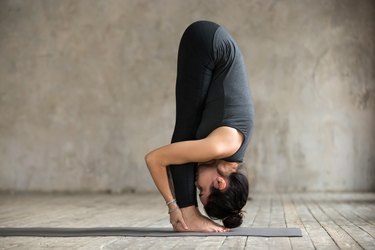
This pose is a great moment to catch your breath, but be sure to maintain good form as you relax in forward fold. In other words, don't force anything.
- Stand up tall, then hinge at your hips and fold your torso forward, hands reaching toward the ground.
- Bend your knees slightly and soften your lower back.
- For added comfort, lightly sway side to side or reach for opposite elbows.
- Hold for 5 to 10 breaths.
Muscles used: hamstrings, lower back muscles
4. Triangle Pose (Trikonasana)
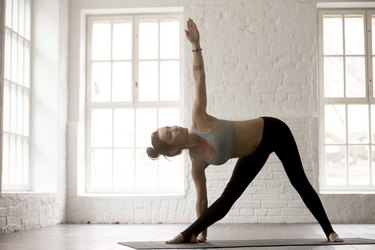
While triangle pose primarily stretches the hamstrings, hips and obliques, it also puts your head and torso perpendicular to its standard alignment, which is perfect for challenging your balance as well as your perspective.
- Spread your feet two to three feet apart, turning your right foot out 90 degrees and your left foot in just slightly.
- Raise your arms out to the side so they're parallel to the floor.
- Bend sideways at your waist, resting your right hand on your right foot, shin or the floor.
- Keep your hips squared forward and level. If you can, rotate your head to look up at your left hand.
- Hold for five breath cycles on each side.
Muscles used: hamstrings, core muscles, obliques
5. Chair Pose (Utkatasana)
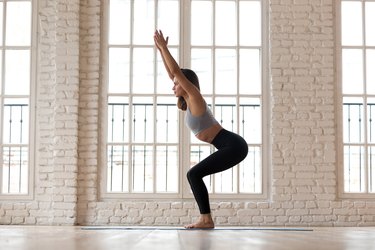
For this pose, you'll need core and quad strength to keep yourself balanced despite your center of gravity being lower.
- Start in mountain pose.
- Root down through your feet as you hinge your hips back and down as if you were sitting in a chair.
- Tuck your tailbone under so you don't put any extra pressure on your lower back.
- Raise you arms overhead in line with your ears.
- Hold for 7 breaths.
Muscles used: glutes, quads, hamstrings, deltoids (shoulders)
6. Lord of the Dance Pose (Natarajasana)
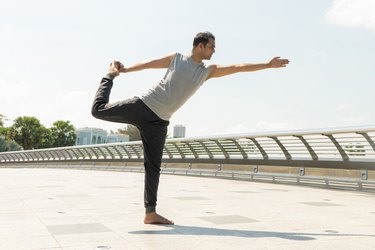
This is definitely an advanced balancing pose, but you can take it step by step and work on your flexibility and strength before taking it all the way.
- Stand with your feet parallel, a few inches apart.
- Bend your left knee back so your left food is behind your and grab your left foot with your left hand.
- Using your right arm as a counterbalance, lean forward as you kick your left foot into your left hand and lift your left foot back behind you.
- If you're using a strap, secure one end around your ankle and hold the other end with both hands over your head.
- If your flexibility allows, grab your left foot with both hands, arms reaching over your head.
- Hold for as many breaths as possible.
Muscles used: hamstrings, quads, abdominal muscles, back muscles, shoulder muscles
7. Warrior II (Virabhadrasana II)
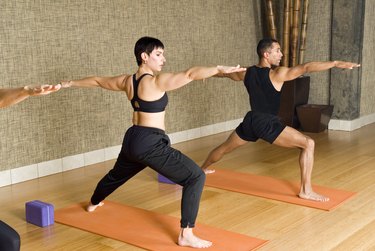
Warrior poses are meant to ground you to the earth and build lower-body strength, both of which are important in preventing falls and maintaining gracefulness.
- Spread your feet three to four feet apart, turning your left foot out 90 degrees and your back foot in 45 degrees.
- Bend your front knee to 90 degrees and square your hips to the side (not toward your front foot).
- Lift your arms up so they're parallel to the ground.
- Hold for 5 to 10 breaths before switching sides.
Muscles used: adductor muscles (inner thighs), quads, abdominal muscles, deltoids (shoulders)
8. Eagle Pose (Garudasana)
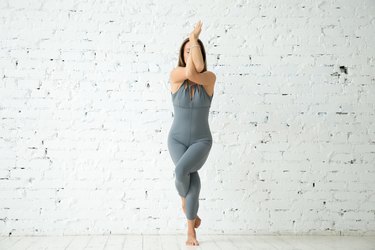
Like tree pose, you'll be balancing on one leg for eagle pose, but you'll also need to rely on your hip mobility and stability to wrap your legs around each other.
- Start standing and slowly shift your weight to your left foot.
- Cross your right thigh over your left and tuck your right foot behind your left calf, if you can.
- Bend both knees slightly.
- Hold your arms out and cross your left arm over your right, intertwining the arms so that the palms touch in front of your face. Remember, whichever leg crosses on top, the opposite arm should cross in front.
- Hold for 5 breaths on each side.
Muscles used: glutes, quads, hamstrings, abdominal muscles
9. Half Moon Pose (Ardha Chandrasana)

Challenge your single-leg balance as well as your hip strength and mobility with half moon pose, which takes triangle pose and tilts it to the side.
- Start in triangle pose (see above).
- Move your front hand out in front of your foot several inches.
- Begin to lift your back leg off the ground slowly.
- Support yourself with your hand and gaze at the floor as you find your balance. Your hips should be squared outward and your back leg parallel to the floor (if flexibility allows).
- Raise your back arm up to be in line with your grounded hand.
- Hold for 5 breaths on each side.
Muscles used: abdominal muscles, back muscles, glutes, quads
10. Warrior III (Virabhadrasana III)

Take what you learned about grounding yourself in warrior II and take flight in warrior III.
- Start in warrior I (feet three to four feet apart, left foot out 90 degrees, right foot in 45 degrees, hips squared over your left leg).
- Raise your arms overhead, and then reach out in front of you as you slowly lift your back leg off the ground. Torso, arms and free-floating leg should be parallel to the floor.
- Keep your arms overhead, out to the side or at heart center.
- Hold for five breaths on each leg.
Muscles used: hamstrings, glutes, abdominal muscles, back muscles
11. Extended Hand-to-Big-Toe Pose (Utthita Hasta Padangusthasana)

This one not only requires a lot of stability, but you also need quite a bit of hamstring flexibility.
- Begin in Mountain pose with your feet parallel and slightly apart.
- Reach down with your right hand to grab your right big toe with your thumb and first two fingers of your right hand.
- Place your left hand on your left hip for balance and straighten your right foot out to the side.
- Keep your hip from jutting out and stand tall.
- Hold for three to five breaths on each side.
Muscles used: hamstrings, abdominal muscles
12. Garland Pose (Malasana)
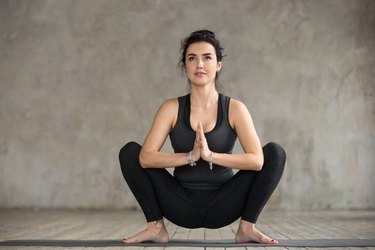
This pose is a fantastic hip opener. Just make sure you don't let your back round and that you use your elbows to open up your hips.
- Stand with feet hip-distance apart or wider, toes pointing out 45 degrees.
- Bring your body down into a deep squat, hands at prayer.
- Hold for 5 to 10 breaths.
Muscles used: glutes, adductor muscles (inner thighs)
13. Standing Splits (Urdhva Prasarita Eka Padasana)
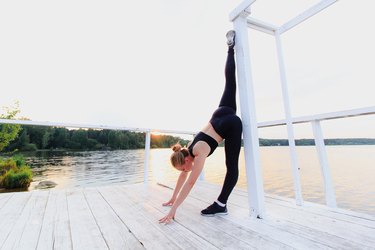
This pose is a challenge, so approach it with caution and be mindful of your alignment. If you don't have the range of motion to raise your leg to the sky, don't push past your range. You'll gain flexibility with continued practice.
- Standing in mountain pose (see above), hinge at your hips and fold forward.
- Simultaneously, raise one leg back and up toward the sky or as high as your flexibility allows without rotating your hip open to the side.
- Bring your hands down to the ground or to yoga blocks in front of you.
- Hold for 5 breaths on each leg.
Muscles used: hamstrings, quads, abdominal muscles